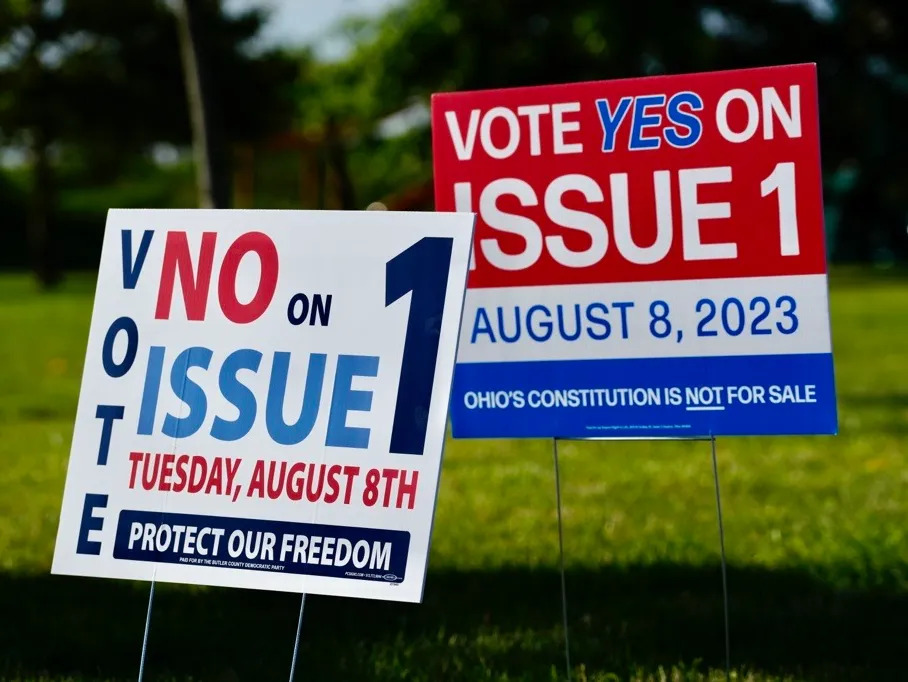In November 2018, Ohio faced a crucial decision: Ohio Issue 1, a proposed constitutional amendment aiming to reduce non-violent drug offense incarcerations. This blog explores Ohio’s criminal justice reform, the amendment’s goals, arguments from both sides and the vote’s outcome.
Criminal Justice Reform in Ohio: The Backdrop
To understand Ohio Issue 1 fully, it is crucial to examine the broader landscape of criminal justice in the state. Like many other states in the United States, Ohio was grappling with an overcrowded prison system, disproportionately housing non-violent drug offenders. The punitive measures that led to mandatory minimum sentences often seemed incongruous with the specifics of individual cases. Ohio’s correctional facilities were strained, and the fairness and effectiveness of the criminal justice system were called into question.
Ohio Issue 1 emerged in response to these challenges, with the aim of introducing a series of reforms that would have a significant impact on the state’s criminal justice framework.
The Ambitions of Ohio Issue 1
Ohio Issue 1 was designed to address several critical issues within the state’s criminal justice system:
Reducing the Prison Population: At its core, the proposal aimed to reclassify some non-violent drug-related felonies as misdemeanors, with the goal of reducing incarceration and emphasizing rehabilitation.
Reallocating Resources: The amendment proposed to redirect the funds saved from reducing the prison population to various avenues, such as addiction treatment programs, victim services, and community safety initiatives. In this way, the initiative sought to tackle the root causes of drug addiction and improve the well-being of communities.
Emphasizing Rehabilitation: Issue 1 was anchored in the belief that the criminal justice system should shift its focus from punishment to rehabilitation for non-violent drug offenders. This transformation involved offering access to treatment, education, and job training, empowering individuals to reintegrate successfully into society.
The Case for Ohio Issue 1
Supporters of Ohio Issue 1 had compelling arguments in its favor:
Cost Savings: Proponents highlighted that reducing the prison population could reap significant financial benefits. Ohio could reallocate the funds saved towards education, public safety, and addiction treatment programs, offering a more fiscally responsible path.
Rehabilitation Over Punishment: Advocates underscored the importance of prioritizing rehabilitation over punishment for non-violent drug offenders. The initiative aimed to help people overcome addiction, rebuild their lives, and benefit society through treatment, education, and job training.
Addressing the Opioid Crisis: Issue 1 in Ohio was seen as a compassionate and proactive response to the opioid crisis, providing a recovery-focused approach rather than punitive measures.
Bipartisan Support: One of the noteworthy aspects of Issue 1 was its bipartisan appeal. It garnered backing from conservatives and liberals alike, as both recognized the potential for a more effective, efficient, and humane criminal justice system.
Voices of Opposition: Arguments Against Ohio Issue 1
However, not everyone unanimously supported Ohio Issue 1, and its opponents raised valid concerns:
Public Safety: A significant argument against Ohio Issue 1 centered on the potential implications for public safety. Opponents worried that reducing sentences for certain offenses could result in an uptick in crime, particularly drug-related offenses.
Weakening Accountability: Critics expressed concerns that the amendment might inadvertently weaken the accountability of individuals convicted of drug offenses. Without the threat of incarceration, some offenders might lack the incentive to seek treatment and rehabilitation voluntarily.
Resource Allocation: Skepticism emerged regarding the allocation of funds saved through reduced incarceration. Critics questioned whether organizations or individuals would genuinely channel these resources toward treatment and rehabilitation programs or divert them to other purposes.
Constitutional Rigidity: Certain drug offenses being classified as misdemeanors in the state constitution raised concerns about the flexibility of the criminal justice system. Opponents argued that constitutionally codifying this change could limit the system’s adaptability to evolving circumstances.
The Outcome: Ohio Issue 1’s Defeat
In November 2018, Ohioans exercised their democratic right, and they ultimately defeated Ohio Issue 1. The initiative did not secure the majority of votes needed to become law.

Ohio Issue 1’s defeat highlights the complexity of criminal justice reform. Balancing the imperatives of public safety, fiscal responsibility, and the humane treatment of non-violent offenders remains a formidable challenge. Issue 1 sparked a significant conversation on criminal justice reform.
The Continuing Debate on Criminal Justice Reform
The rejection of Ohio Issue 1 does not mark the end of the journey towards criminal justice reform. It shows consensus for reform; however, even if a proposal’s details don’t resonate with voters.
The issues and aspirations that drove Issue 1 continue to be relevant and vital. Ohio, like other states, seeks a fairer, more effective criminal justice system. The conversation continues, and the path toward reform remains an ever-evolving and critical endeavor.





















